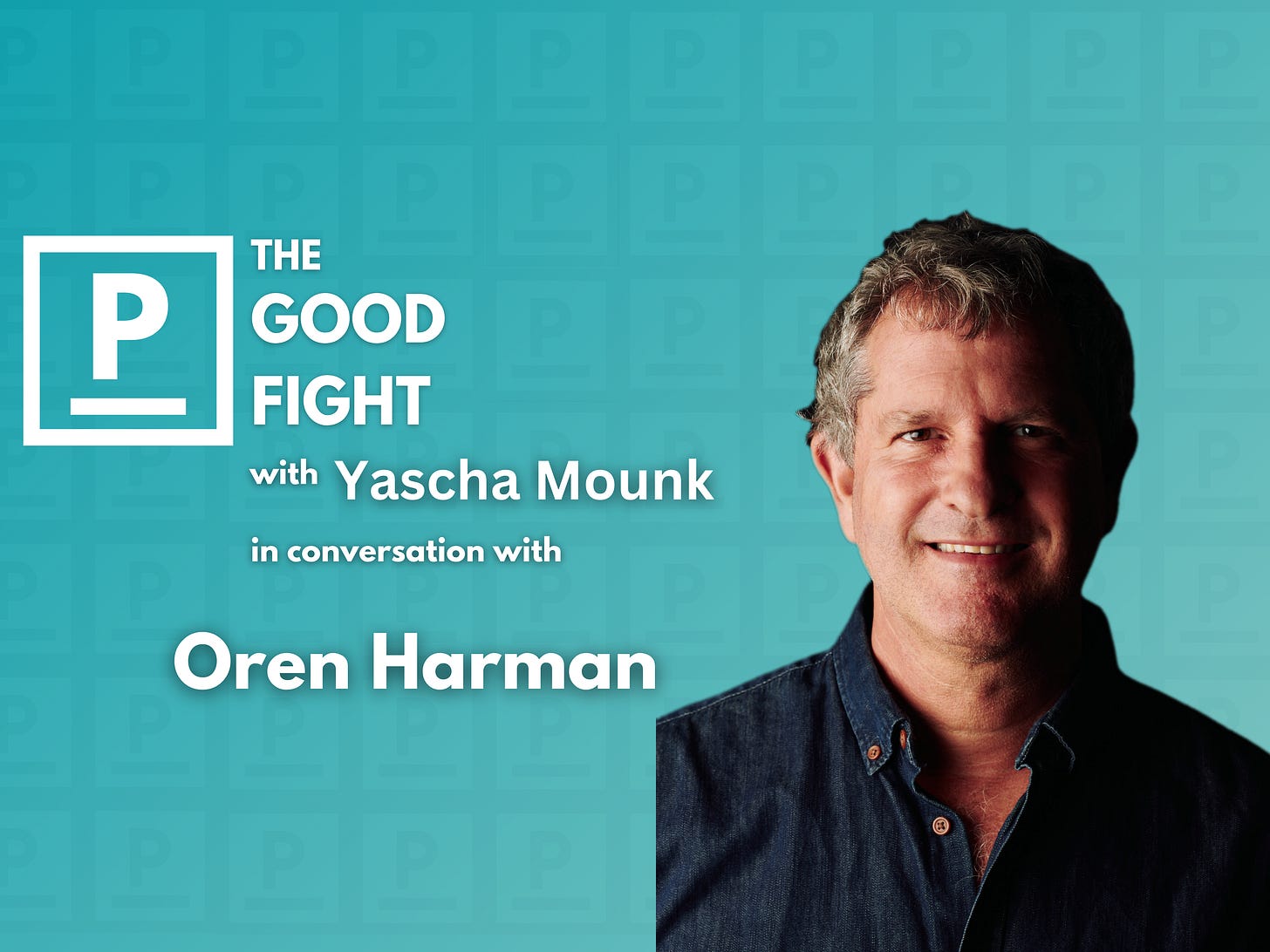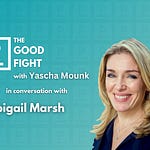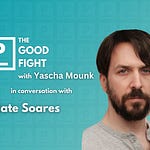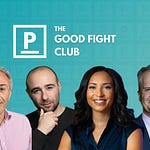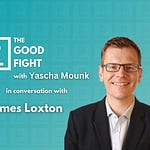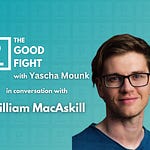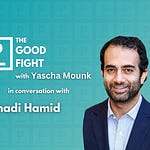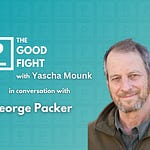Oren Harman is a Senior Fellow at the Van Leer Jerusalem Institute and teaches at the Graduate Program in Science Technology and Society at Bar Ilan University. His latest book is Metamorphosis: A Natural and Human History.
In this week’s conversation, Yascha Mounk and Oren Harman explore the evolutionary benefits of altruism, metamorphosis in the world around us, and how it impacts our perception of human growth.
This transcript has been condensed and lightly edited for clarity.
Yascha Mounk: You’re writing about subjects that don’t immediately touch on politics but are actually interesting to think about from a political perspective. In a way, you’re trying to answer some puzzles about evolution. Why is it that a caterpillar turns into a butterfly when that seems an unnecessarily complicated process from an evolutionary perspective? Why is it, as you explored in a previous book, that many of us are capable of altruism, and many animals are capable of altruism, even though you would think that in an evolutionary process favoring the survival of the fittest, you would end up selecting against that kind of altruism? Why don’t we start there? Explain the puzzle to us first. What’s so puzzling about altruism?
Oren Harman: Darwin himself recognized the puzzle when looking at social insects, where you have entire classes of bees, termites, and ants that appear to forgo reproduction altogether in order to sacrifice their lives for their queen. From a biological point of view, their fitness is zero. They don’t reproduce and are negligible from an evolutionary point of view. That seems to make no sense if evolution is a game of survival of the fittest. Why would a characteristic that reduces fitness evolve over time? Darwin wrote, “If I cannot find a good solution to this problem, my entire theory is worthless.”
Mounk: He really was bothered by this. It wasn’t just an interesting little puzzle. He felt that it was a challenge to the core of his scientific worldview.
Harman: For sure, and his answer was that it’s for the good of the community—what we would today call group selection. For many years in the twentieth century, group selection was considered very fuzzy thinking and bad science. When you think of two groups competing with one another, what would be your guess as to which group would be stronger in this competition: a group full of altruists or a group full of egoists?
Mounk: I would guess that it’s a group full of egoists.
Harman: Well, you would guess that it’s actually the group full of altruists because they’re all cooperating with one another. The egoist would be every man for himself. The altruists come together.
Mounk: Oh right, yeah. But within the group, it’s the egoists that would win.
Harman: Exactly. Within the group, if you’re a selfish person, then when everyone runs ahead to fight the enemy, you take a step back and live to tell the story the next day. If this characteristic is inherent in you, if it’s a trait that can be passed on biologically, then over time there’s a problem of stability for the altruistic group.
Mounk: The standard example of this that I remember, I think from Jonathan Haidt’s book The Righteous Mind, in which he has a chapter on group-level selection, is that we might say, look at that fast herd of gazelles over there. The objection of those who are skeptical about group-level selection is to say, it’s not a fast herd of gazelles; it’s a herd of fast gazelles.
What happens is not that an entire group of gazelles is wiped out by a lion and some other entire group of gazelles survives. Each time, the slowest gazelle gets eaten. Over time, the gazelles become faster because those are the ones that survive and pass on their genetics. What looks like group-level selection—that the fast herd survives while the slow herd doesn’t—is actually individual-level selection.
Each time, what happens is not that a lion eats all of the gazelles, but that it eats the slowest gazelle. So what is the response to that?
Harman: For Darwin, marshaling a sort of Victorian morality, it was uncomplicated. This was for the good of the community, as he called it. Later on, we became aware of the logical problem in this explanation. Ever since Darwin, and until this very day, scientists of different stripes—mathematical population geneticists, evolutionary psychologists, economists, and other thinkers—have tried to approach this problem with different tools.
The book I wrote, The Price of Altruism, is about a man named George Price, who wrote a mathematical equation in the early 1970s that offered a deep treatment of the dynamics of natural selection. It helped explain the evolution of traits where there is a conflict between different levels of the biological hierarchy—between the individual and the group, or between the individual and the genes within the individual.
He wrote that equation and then became an evangelical Christian because of his philosophical interpretation of its meaning. To him, the equation showed that true altruism—true selflessness—doesn’t really exist in the world. There is always, as he puts it, “scratch an altruist and watch an egoist bleed.” Once a Christian, this was a terrible realization for him because Christianity was all about sacrifice.
He ended up killing himself in a squat in London in 1975. He was a forgotten figure but also a great genius, and that book was about him, using his story to tell the larger story of where kindness comes from.
Mounk: What is the response to straightforward arguments that smart undergrads can make in a philosophy class about why there isn’t such a thing as altruism? One argument is that we’re driven by our utility function. Perhaps that function isn’t narrow—it’s not only about how many dollars are in your bank account. When I do a favor for my friend, it is either because I hope they’ll reciprocate in some way, or because it gives me pleasure to see my friend helped. Even then, what drives me is my own pleasure. It gives me pleasure to look after my dog and see my dog run around happily.
Harman: An argument against these ideas is that we are deeply social creatures. It was crucial for our survival to cooperate with one another, to tolerate one another, and to live together without killing each other. Gradually, we developed the biological substrates at the genetic, neurological, and anatomical levels that allowed us not only to live with one another and cooperate beneficially, but also to genuinely empathize with one another. That is built into our biology. What is interesting about us is that both traits exist at the same time.
Thanks for reading! The best way to make sure that you don’t miss any of these conversations is to subscribe to The Good Fight on your favorite podcast app.
If you are already a paying subscriber to Persuasion or Yascha Mounk’s Substack, this will give you ad-free access to the full conversation, plus all full episodes and bonus episodes we have in the works! If you aren’t, you can set up the free, limited version of the feed—or, better still, support the podcast by becoming a subscriber today!
And if you are having a problem setting up the full podcast feed on a third-party app, please email our podcast team at leonora.barclay@persuasion.community
It is often up to external conditions which trait manifests more strongly, as well as to education and culture. The blessing of being human is that we have this double nature—the blessing and the curse. It is up to us to create the conditions that allow the more empathetic, sympathetic, cooperative, and sacrificial traits to manifest, rather than the egotistical and self-serving ones. We must create those conditions and teach ourselves to be better. It will not happen on its own.
Mounk: I’m trying to think about how that operates in different kinds of animals. Presumably, the bee that sacrifices itself for the queen is not acting rationally. It is not making conscious choices about whether to sacrifice itself. It follows an instinctual biological program.
Would you say there is something similar in human beings? When we see someone being attacked in public, some people are cowardly and do nothing, but some will stand up and protect that person. Is that an instinctual response that overrides rational self-interest in a way that parallels the bee sacrificing itself in that situation?
Harman: There are studies showing that a certain percentage of humans act instinctually in ways that are not rational. For example, you see someone fall onto train tracks and you jump after them. That percentage seems to be quite robust—about 10% of people will do that.
It has been very interesting for scientists to study these people more closely. What makes them such remarkable altruists? The jury is still out. There are many attempts to reduce complex behaviors to simple biological explanations—to find the cause in their genes or their brains.
At Stanford, for instance, there is a center for the study of human well-being and kindness that was initially funded by the Dalai Lama. Researchers there literally place Buddhist monks in fMRIs to see whether their brains function differently. These scientific attempts exist, but I feel they will always come up short. The biological leash is not short enough to explain all of our behavior instinctually. Clearly, we have that instinct within us, and some exercise it in ways that continue to amaze us.
Mounk: I was happy to see in one recent study that when dogs see their owners, the region that corresponds to feelings of happiness or endorphins lights up very strongly. That seems to be independent of whether or not they are given a treat. Even if loving their owners may be an evolutionary strategy at some level, at the level of experience it doesn’t seem to be instrumental in that way.
Harman: I think there is what we call in human terms kindness or empathy—an ability to love one another—that is genuinely in us. George Price killed himself after writing this remarkable equation, which advanced our understanding of the evolution of a trait like altruism. He was wrong in philosophically interpreting his equation to mean that there is no true selflessness in humans. He was wrong. So there is hope.
Mounk: It seems there are two different levels of thinking about this. One is what motivates us and what our experience of the world is. The other is why evolution created us to be motivated in this way. Whether we are talking about a dog that genuinely loves its owner or about humans who have genuine love and empathy for family, friends, partners, or even for a stranger being assaulted on the street, most have this kind of genuine empathy.
There may be someone who hopes to gain a reward, a sociopath trying to move through social life, but that is not true of most human beings who act altruistically in this way. The second question is why evolution led to human beings who are capable of that kind of empathy and altruism. That question is at a rather different level.
Harman: We suffer from a bias of originalism. We think that if we can understand the origin of a certain trait, then we have understood that trait entirely, which is not the case. There is a difference between why a trait evolved, why it was selected in the first place, and what happens once it becomes an ingrained capability.
Mounk: That’s a mistake we often make in politics nowadays. It’s been labeled for a long time the genetic fallacy, the idea that if you can show that something has problematic origins, then it must be bad today. That often doesn’t follow. Perhaps the old age pension scheme in Germany has problematic origins as an attempt by Bismarck to keep down the demands of the working class and to stave off socialist revolution.
To conclude from that that you should be normatively opposed to the old age pension scheme in Germany today would be a categorical mistake. Let’s get back to that second level of the question. If it’s obvious that we can have genuine altruism, genuine empathy, genuine fellow feelings, the question still is, why is it that evolution selected for that? If the fast herd of gazelles is actually just a herd of fast gazelles, and that seems to show that cases of what look like group level selection turn out to be individual level selection, then how do you get the bee that is not individual-level selected, that has zero chance of passing on its own genes?
Why is it that people sometimes sacrifice themselves for strangers with whom they don’t necessarily share a lot of genetic material? Wouldn’t the people who do that end up being selected out? If 10% of people are the kinds that are going to jump on the train tracks and rescue somebody when the train is oncoming, aren’t they going to keep reducing as a share of the human population because they have a higher likelihood of being hit by a train before they have kids? If that’s the case, aren’t they eventually going to die out?
Harman: That’s probably why their level is down to where it is, about 10%. But that is a kind of equilibrium because they end up being crucial for the cohesion of the group. It is crucial to have such people who are able to exercise, almost instinctually, a care for others that transcends politics and culture. The answer is no, these are the dynamics of group selection in our case.
Mounk: Tell me what that means. Let’s say there are sociopaths who are not altruistic in any way, and then there are garden-variety altruists who have all kinds of altruistic behaviors but are not exceptional altruists. Then there’s this group of super altruists. Is your contention that when the level of super altruists falls below 10%, this has such adverse effects on the group that a group containing so few of them will be outcompeted by other groups that have more of them? So, even at the individual level you’re selecting against the altruists, but at the group level, you’re selecting for having at least that one-in-ten share of altruists, and that’s why that’s the equilibrium.
Harman: There are studies that point in that direction. One of the traits of a sociopath is that he or she doesn’t blush. What does that tell you? Blushing was a signal that, evolving as a social species, you have internalized the norms of the group. You blush because you understand that you’re doing something wrong. The sociopath doesn’t blush. We have all of these ingrained biological mechanisms whose evolutionary rationale is to signal to the other, you can deal with me, or I am friendly. All of us have that. Some of us can be thought of as a kernel surrounded by ripples that spread outward. These ripples represent how far our concern or altruism extends. For whatever reason—and although there is biological variation in the population when it comes to these traits—it isn’t just biology, as we discussed with the myth of originalism. Some of us stay close to the core, meaning we tend to look out for ourselves more. Some of us have been able to have this ripple go out and extend from us outward in ways that reach something which has been called pathological altruism, where you give like crazy.
What happened with George Price is, when he perceived this equation to be a terrible realization, he said, I will show with my own actions in my own life that I can transcend this miraculous mathematics. He went out to the streets of London and became a radical altruist, which is what he did. He gave away everything. He started by giving a pound or two, then buying sandwiches, then helping these people on the streets with their woes with the law and the police, representing them in courts of law, and inviting them into his one-bedroom apartment until he had nothing. He literally gave away everything and became a homeless man on the streets of London himself, which is where he killed himself in a squat in 1975. So you have the whole gamut, as with most complex behavioral traits. There is variation across the gamut, and it is good that we have that variation. Variation is the lifeblood of evolution.
Mounk: Tell us more about this pathological level of altruism. Presumably we have a garden-variety altruism, which seems well adapted. Then we have the 10% of people that we would probably call heroes and admire. The willingness to risk your life to save a stranger from an oncoming subway car is something that, under many circumstances, we think is a positive trait.
If it is obvious you are not going to save the stranger and that you are going to die in the process, then perhaps it would be smarter to stand out on the platform. In many of those circumstances, the chance of saving the stranger is much higher than the chance of coming to harm yourself. It takes courage and altruism. When people do that, it is something admirable and, in some ways, rational. It is not rational in the narrowest definition of the word; it is not maximizing your self-interest in some kind of very narrow economic sense.
It is something that does not seem like a kind of crazy Don Quixote-style caper, where you are doing something that seems obviously ill-advised, even though it might, at some level, be admirable. When do we cross the boundary?
Harman: Well, I think that is a normative question. It is down to what we define as pathological. For instance, in my culture, there are groups within the culture that, for cultural and religious reasons, have become radical donors of kidneys and lungs. It is a sort of trend that spreads like wildfire in the population. This is a population of settlers, interestingly enough. When that was satiated to some degree, women began giving their wombs to other women who could not have babies.
Who is to say whether this is pathological or not? It is clearly a trend. It is clearly driven by cultural considerations. It has to do with identity and with the way a particular group defines itself as opposed to other groups. The question of pathology is one that we determine in our cultural wars, and it will be something that changes over time.
Mounk: It is interesting, but I think this is where the distinction between an in-group and an out-group comes in. At least my mental model of the world has come to be, which was not always like this, that we are hardwired to have some amount of altruism and courage in dealings with the in-group. When we have a strongly defined in-group, that is often when we become capable of sacrificing ourselves, as humans have done for many centuries and millennia in war under certain circumstances, but also for performing genuinely altruistic acts, like giving up a kidney for somebody in our community who may not even be a sibling or a cousin, but someone we relate to as part of our in-group. Interestingly, that can go hand in hand with very cruel treatment of the out-group.
Harman: It is not only that it can go hand in hand, but that necessarily, in evolutionary time, these were requisites of one another. In other words, the reason group selection works is that it leads to the cohesion of a group so that the group can smite the external group. That was its initial cause and rationale in selective terms.
This does not mean that we need to strap ourselves to this rationale and have it be true until the end of time. This is where it began. In fact, without the enemy, the external enemy, the out-group, you could not develop these internal mechanisms for group cohesion, which were so strong that they became genuinely ingrained in our biology.
What is beautiful about the evolution of culture over history is that we have been able to use these characteristics that are embedded within us. They were embedded for reasons that today we might see as quite vicious and violent, and we have used them to extend our degrees of empathy to the out-group and beyond. To some degree, the types of challenges we face as a species on planet Earth will require us to extend these degrees of empathy so that we can come together and solve challenges, such as when a pandemic comes our way. We need to be able not to see the political borders that divide us, but rather to see our common humanity in order to fell such a scourge.
Mounk: I think that is what is interesting about this charge, that in a particular case, altruism has become exaggerated or misguided. It can apply to the individual case, like Price, where you are no longer keeping even the basic possessions you need in order to have a decent life yourself. That may ultimately result in you being so destitute and so desperate that you commit suicide and are no longer able to help others.
That seems self-undermining, and even from a kind of Kantian universal imperative perspective, it seems like an irrational thing to do because you cannot sustain the level of prosperity you need in order to keep helping others. More often, I think what is meant by that charge is the claim—whether true or false, rational or irrational—that you are not helping your in-group in the right ways. When people say there is something pathological about your altruism, what they often mean is that, rather than helping your in-group, you are naive about the intentions of the out-group and are helping them.
Harman: I think that is true. I see it in my own culture today, where we are fighting a terrible and violent war in Gaza. Israelis who say, wait a second, there are many innocents being killed in Gaza. What the hell is happening here? What are we doing? are often branded as traitors from within by nationalists who say, we have a real, true and vicious enemy in Hamas, but if you show empathy, this type of empathy is self-sacrificing. If you hold these views, we will not survive.
Of course, as ever, every form of human behavior can be shown in such a way that it looks as if it is an abuse when it really is not.
Mounk: What do you think is the right balance between the positive role that a strong in-group can play—the ways in which it can give us belonging, identity, and solidarity, and ensure that our group survives group-level selection, which is one of the evolutionary mechanisms at play, as you are saying—but at the same time, that it does not lead us to lose our humanity in such a way that we start to justify anything that might be done to the out-group, with the excuse that to care about that would be a form of pathological altruism?
Harman: I think this is a question that humans have asked themselves. I think of the pacifists in World War I. There were international pacifists in Germany, France, and England, who, the moment the shooting began in 1914, faced a great dilemma. Some of them remained idealistic, while others said, wait a second, there is a real and immediate danger now, and we have to come to the front.
I think this question boils down to being able to discern when a danger is truly a danger and when a danger is really a bias. When a danger is a cultural bias, when it comes down to views that we should unpack, contextualize, and try to improve upon—to be better people. That will always be a very fine line. There will always be arguments about it. There will always be certain people calling others traitors for being more capacious and for having a lower threshold of angst before danger.
When Angela Merkel said, Germany is a strong nation, we can absorb all of these refugees from Syria, there were Germans who said, what are you talking about? This is going to be detrimental. Others said, way to go, Angela, that is the better side of humanity that we all want to move toward.
Mounk: We have been talking a lot about altruism, which is one kind of evolutionary puzzle. You have just published a book that investigates another evolutionary puzzle—that of metamorphosis. Why is that an evolutionary puzzle? It is surprising that if you want to build a butterfly, you do not start by building a butterfly. You start by building a caterpillar.
Harman: Most of us think of tadpoles and frogs, and caterpillars and butterflies, when we think of metamorphosis. It seems quaint and almost childlike. It is related to our childhood, and we think of it as idiosyncratic and not very representative.
Today, biologists estimate that three quarters of all animal species undergo some form of metamorphosis, which is an extraordinary figure because it means that they need to go through what is defined as radical or dramatic post-embryonic development. It means that you need to go through that in order to become who you are.
Mounk: Is that because biologists have hugely expanded the definition of what they mean by metamorphosis? Is that because there are far more species of butterflies than we thought? Give us some examples of where there is metamorphosis that we might not typically think about.
Harman: It is because there are different forms of metamorphosis. Take a starfish. A lot of marine invertebrates metamorphose. A starfish starts out life as an egg, as all living things do. Then there is a developmental program that begins to turn that egg into a juvenile, what we call a larva. In the case of the starfish, the larva is bilateral. In other words, it has the symmetry of you and me. It has a top, a bottom, a back, and a front. It exists as a pelagic creature in the water. It kind of has wings. It looks like a little angel—a translucent angel.
At a certain point in time, a second developmental program begins within its stomach and starts to create the adult, which has a completely different symmetry. It is radial. It does not have a back and a front, a top and a bottom, in the same way. Gradually, it grows to a certain size and migrates to the tips of its own juvenile. Then, in a kind of immaculate consumption, it falls to the bottom and becomes sessile. The adult and the juvenile exist simultaneously. In some sense, the juvenile has birthed the adult.
Each one of these creatures has the exact same genome in each of its cells, but you would have no idea, if you saw these two creatures together, that they have anything to do with one another. In human terms, this is very strange. We almost do not have the language to describe this relationship because one is not the father of the other. They are not cousins or brothers. They are, in fact, an identity but different manifestations of the same identity.
Mounk: It is amazing. Darwin is incredible. I never really read The Origin of Species. A few years ago, I downloaded it on Audible. It happened to be offered for free, or perhaps I used a credit to buy it, I forget. It is so contemporary, so easy to follow, and so vivid. It is an incredible piece of literature.
Harman: He was a great writer, for sure. There are many manifestations of metamorphosis in nature, and different gradations of it. In insects, you have the creation of the chrysalis, or a cocoon in the case of moths, where what emerges looks nothing like what went in. This is called true metamorphosis, or complete metamorphosis. There are gradations—semi-metabolous creatures and so forth—but three quarters is a crazy number.
Mounk: The obvious question is why, right? I can see how there is an ecological niche for butterflies. If you want to create a butterfly, why go through the work of creating a completely different kind of creature and then have a butterfly evolve and grow out of that completely different kind of creature?
If you want to have a very simple kind of animal that lives in the sea and can barely do anything, why create a complicated animal first that then turns into this super simple animal? That seems like an incredible amount of wasted effort. Is this a weird accident of evolution and how the biological program came about, or is there some genuine evolutionary fit that comes from these different kinds of phases? I presume that is the obvious question to ask about this.
Harman: Before we get to the solutions, there is a really fascinating history when it comes to this conundrum. It goes all the way back to the ancients, and people like Hippocrates and Aristotle and Pliny the Elder. They all weighed in. They lived in an ancient world that was suffused with miraculous transformations.
Gradually, the thinking about them morphed itself into a science. So people like Virgil, the Roman poet Virgil, counseled honey-makers to bury a bull with its horns above ground, just this amount, and then wait for nine to thirty-two days and then cut the horns. That was the way to get bees because bees would come flying out. Pliny the Elder said that silk moths come from vapor on rainfall and oak blossoms. Other people counseled that women’s hair, if it got hot enough, could turn into snakes and so forth.
This was a preoccupation of the ancient world. Probably the most important influence was Aristotle, as with many things, who spoke of a causal universe in which things happen to creatures because it is in the nature of those creatures to become who they are. In the case of metamorphosis, what he wrote was that only the act of sex between a male and a female could provide nature to a creature—only a father who gives a creature its essence, its eidos, and a mother who gives its form. The father was much more important because the essence is more important. The female was only the form.
Insects, whom Aristotle thought were generated spontaneously, had to transform again in order to become who they are because, unlike us humans, they were born imperfect. What is really interesting when you look at these ancient attempts to understand metamorphosis is that Aristotle saw butterflies and ants and all kinds of other insects having sex. But the theory was so much stronger than what he observed that it trumped what his eyes saw, and he stuck to his guns.
Mounk: This reminds me of a favorite piece of writing of mine by Tony Judt in The Memory Chalet, where he describes the graduate of École Polytechnique in France who was sent to observe the first train between Manchester and Leeds in the 1830s and to report back about this worrying technological advance of the rival nation of the United Kingdom. He goes and observes everything perfectly, does some very detailed calculations as an engineer, and reports back to the École Polytechnique that trains are scientifically impossible.
Harman: Exactly. Aristotle insisted that women have fewer teeth in their mouths than men do because of the way he thought of the difference between, and his culture thought of the difference between, the essence of a woman and the essence of a man. You want, from 2,500 years into the future, to sort of scream at him, “Aristotle, why don’t you open your wife’s mouth and just count the teeth,” and so forth.
It does not work that way because our ideas are always deeply enmeshed in the cultures that produce them. To return to metamorphosis, these ideas of the ancients were then Christianized in the Middle Ages by people like Aquinas and Albert, and by Jews and Muslims like Ibn Khaldun and Maimonides, who adopted these views of transformation to their own communities. Yet, even by the seventeenth century, we did not know how a man and a woman make a child, much less how a butterfly emerges from its chrysalis.
Mounk: What do you mean we didn’t know how a man and a woman make a child? Surely by the 17th century, humans knew that.
Harman: We hadn’t found an egg. This is an incredible history, which I write about in the book. We did not know what the female egg was.
Mounk: So we knew about the act of sex and we knew about the relation between the act of sex and getting pregnant, but we didn’t know about the anatomy or biology.
Harman: We knew that men had sperm. We were looking for what it was that the female brought. Aristotle, Galen and others thought it was the menstrual blood. There were many attempts to find what was called a female testicle and to find the egg. Until the seventeenth century, we really did not know how that worked. We did not know whether it was the sperm or the egg which gives the creature its essence or maybe just its form.
We also did not know whether all creatures existed like babushka dolls in miniature within their parents, going back to the Garden of Eden and to the origin of the world, as the Bible told. It was a gradual development of many discoveries made by a cast of quirky and egotistical gentlemen, and also a very extraordinary woman named Maria Sibylla Merian, often called the mother of ecology, who traveled to Suriname when she was fifty-two years old to look at the life cycle of exotic tropical butterflies. She began to figure out just how living things are conceived, how they develop, and how they reproduce—three terms that had all been bunched up together for millennia under what people called generation.
What is really fascinating about this story is that it turns out that cracking how metamorphosis worked was crucial for understanding these very fundamental questions about all life.
Mounk: How so? What’s the connection?
Harman: It is a long and involved story, but I would say the crux of it is that you had to understand that in metamorphosis, unlike what the ancients believed, this was not a phenomenon of spontaneous generation, that there was always an egg involved, and that all of life came from an egg. This was crucial for other scientists, not working on metamorphosis but in some cases working on both, to go out and search for an egg in the uterus of females.
It is a really interesting connection between metamorphosis and understanding how creatures are made. Also, remember there was no concept of a species, a stable species, in the same way that there was beginning with Darwin. People really did believe, and this was the best science of their age, that anything could turn into anything. A human being could turn into a rabbit. These were beliefs that were, in some cases, published in the Transactions of the Royal Society of London.
Mounk: That helps to explain the long-standing obsession that people, up to and including Isaac Newton, had with alchemy. If humans can turn into rabbits, then surely something must be able to turn into gold.
Harman: Exactly. These things are all related, and you have these wonderful characters who, from our point of view, seem extremely colorful, moving between these worlds of inanimate objects and living creatures and applying the same notions of transformation to both. In the nineteenth century, the question of metamorphosis suddenly becomes a question about evolution, and why, to return to your question, nature would go to such lengths to turn creatures into what they eventually become.
There is a wonderful piece of writing by Orwell in which he observes a spadefoot toad from the Sonora Desert emerging from the ground after ten months of sitting completely still without eating or moving. He says this toad looks like a strict Anglo-Catholic towards the end of Lent. Its shrunken body allows one to see what you would not see otherwise—that it really has the most beautiful eyes of any living creature on the planet. He calls it a gold color, and I think it is called chrysoberyl, he writes, or something like that. But what Orwell neglected to tell his readers is that all of the drama had already happened before this frog emerged from its pond.
To transform from a tadpole into a frog that can live on land, it has to switch from breathing underwater to breathing on land. It has to exchange aquatic for terrestrial locomotion. It has to change its diet of plants and tiny water bugs to flies, crickets, and earthworms. Its skin has to adapt to life above water—to the sun, winds, and rain. Gills have to become lungs. It has to grow a new cardiovascular system to carry hemoglobin and a new immune system because the dangers that lurk underwater are very different from those that prowl on land.
New color patterns have to invade its skin to make terrestrial camouflage possible. It has to recut its throat in sync with chest muscles to allow females and males to breathe above water but also to call each other to mate. Front and back legs grow internally and then pop out spontaneously. The tail is absorbed, the gut is shortened, the heart arteries are newly retooled, the eyes are reformed into those gems that enchanted Orwell, and, most amazingly, the brain is completely rewired and encased in a bony cranium. There is an enormous amount of massive destruction of tissues and organs, cell death and regeneration, genetic reprogramming, and anatomical remodeling, and all of this happens in a matter of weeks. It is a great question, and scientists today—modern science—return to this challenge, the double challenge: how does all of this happen, and why does it happen?
In a general sense, if you think of metamorphosis as a mechanism to restrict intergenerational competition, then if you look like one thing when you are young, eat a particular food, and live in a particular area, and then grow into something completely other, eating a different food and living in a different area, you will restrict the competition between young and older, between juvenile and adult. That is one general explanation for why metamorphosis evolved. But it is not good enough.
Mounk: I see. The idea is that if a puppy dog and a grown dog nourish themselves from the same kind of thing, then in an ecosystem where they do not have humans to hunt bulls for them and give them bully sticks, they are going to be in competition with each other. In competition with each other, the small dogs are going to lose out because they are less strong and possibly less agile. That creates a problem.
One way around that problem is to have the young animal, before the metamorphosis, search for very different kinds of nourishment. Presumably, that assumes that the relevant level of analysis is within the same species or within a set of species that go through a similar kind of metamorphosis. If there is competition for that resource from other species that do not go through that kind of metamorphosis, those very simple creatures still have to search for the same kind of nourishment in competition with those other creatures.
For whatever reason, avoiding the competition within the same species is sufficiently important that this still retains a big evolutionary advantage. Is this not a further set of questions we have to answer there?
Harman: Yes, those are important questions. What is amazing when you look at nature is its specificity. A particular species will only eat a particular plant and nothing else. It has evolved to specialize on this plant. Within species, the ability to reduce competition within the species is crucial for that reason.
Nature is full of surprises and full of deceit. There is a particular type of blue butterfly, which is now under threat in many places in Europe.The egg turns into a little larva, which is a tiny auburn-colored thing, and it drops from the tree onto the ground. It emits a chemical signal that attracts a very particular species of ant, a myrmica. Only that species of ant will react to this chemical signal, and it will come, thinking that it has discovered its own. It will carry the larva into its den and feed it at its own expense because it was deceived. Some months later, once it has grown, the chrysalis will open up, and a beautiful blue butterfly will emerge.
There is interspecies competition all the time and a great amount of deceit. Anything that gives a species a certain edge will have a chance of being selected. In a general sense, reducing that intergenerational competition is important. But in insects, there seems to be a trade-off between growth and differentiation. You need to grow as much as you can before you differentiate into the form that will allow you to be a sexually reproducing creature.
There are many studies on this. I spent the last year in a lab at the Freie Universität in Berlin with a team performing studies to understand the exact dynamics of this trade-off between growth and differentiation. That is another explanation.
Another explanation that is used is that you get rid of all your gut biota when you destroy your gut and create a new one. It is an immunological explanation for metamorphosis. You change your gut residents, which makes you stronger because you start anew.
These are some of the explanations that have been given. It is interesting when you look at how we have imagined metamorphosis through three different orders: philosophy, God, and science. The ancient Greeks looked at a butterfly emerging from its chrysalis as a kind of proof of a causal universe leading to us. Lowly insects and slimy frogs had to transform because they were imperfect, unlike humans.
Medieval Christians looked at the same phenomenon and imagined it as a reflection of divine will. The transformation of a wriggly worm into a flying jewel was an earthly reminder of the transfiguration of Jesus to Christ, saying that redemption is possible.
Today, we think of metamorphosis as a scientific problem in genetics and physiology and as a road taken for reasons that we are still trying to discern on a blind evolutionary path. We speak of genes, hormones, and molecular clocks, and we use amazing technology. You can use a 3D microcomputed tomography camera to see exactly what is happening at every stage of metamorphosis within a chrysalis and track each and every nerve cell that migrates and rewires to turn the brain of a caterpillar into the brain of a butterfly. It is amazing. These are things that were unthinkable just a generation ago.
In the rest of this conversation, Yascha and Oren discuss how humans experience metamorphosis and how this affects the law and society. This part of the conversation is reserved for paying subscribers…




